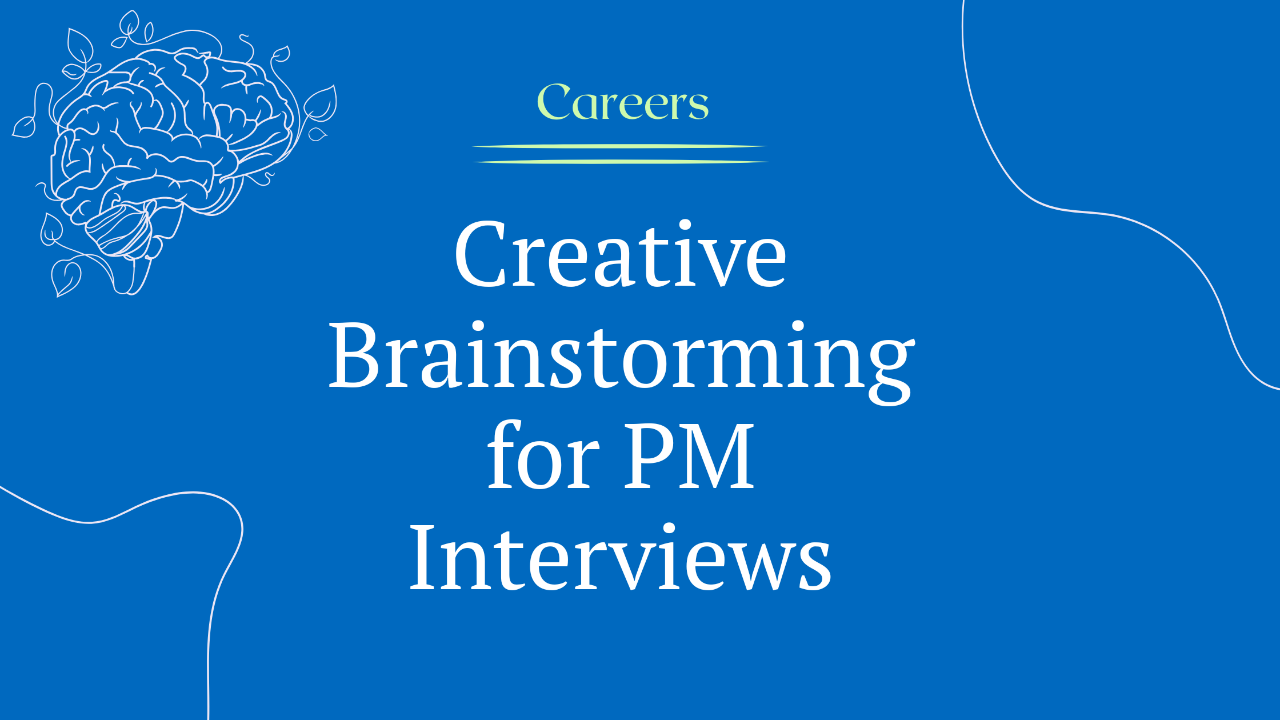💼 How to Brainstorm Creative Ideas for Product Interviews
Oct 26, 2025
If you're prepping for product design interviews, there's one skill that always sets standout candidates apart:
How well you brainstorm.
And I don’t mean just tossing out random ideas. I mean real, thoughtful brainstorming rooted in the user, the problem, and the goal.
Whether you're working on a whiteboard challenge or trying to improve a real product, the best candidates come ready to think on their feet — with range, structure, and a little creativity.
Here’s how to practice that muscle.
The Goal of Brainstorming in PM Interviews
Product design questions aren’t about being “right.” They’re about how you think.
The interviewer wants to see:
-
Can you connect ideas back to the user?
-
Can you explore multiple paths before picking one?
-
Can you think beyond the obvious?
Guidelines for Better Brainstorming
Before we get into frameworks, let’s lay some ground rules:
-
Think big. Your first idea is usually your most basic one — let it go.
-
Generate at least 3 options. Variety shows flexibility.
-
Stay grounded in the goal and user pain.
-
Let yourself play. Creativity often comes from permission, not pressure.
The “Pastrami or Armpits” Framework
Yes, it sounds weird. That’s the point — you’ll remember it.
Use it to generate ideas fast during product interviews or design sprints.
Each letter prompts you to explore a different angle:
P – People
A – Audience
S – Simplify
T – Technologies
R – Remove
A – Add
M – Market
I – Improve
Let’s break it down.
🧍♀️ People
-
Who else could be involved in the product?
-
Can a second user group or support network be looped in?
Example: Add family/group meditation sessions to a wellness app.
🧑🤝🧑 Audience
Go back to the user’s:
-
Needs (what’s essential?)
-
Pains (what sucks right now?)
-
Wants (what would delight them?)
Ask: Which of these is the biggest lever?
✂️ Simplify
-
Can you reduce the steps in the experience?
-
Save the user time, effort, or cost?
Example: Apple Watch reminders for walking meditations.
🧪 Technologies
-
What new or emerging tech can enhance this product?
-
How can delivery evolve?
Example: VR relaxation lounges for meditation or wellness apps.
❌ Remove
-
What part of the experience is clunky or irrelevant?
-
What friction points can be eliminated?
Example: Skip intro sessions for advanced meditation users.
➕ Add
-
What adjacent tools, features, or steps can enhance the experience?
-
What’s missing before or after the core user journey?
Example: Add habit tracking or mood journaling to a mindfulness app.
📦 Market
-
Are there related tools that users already love?
-
Could you bundle something that makes the product more valuable?
Example: Pair Headspace with a chatbot therapist or online coaching service.
🔧 Improve
-
What’s already working, and how could it be better?
-
How can you improve the core experience — or a key competitor?
Example: Add AI-based personalization to recommend meditations based on user mood and behavior.
Example: Brainstorming for Headspace
Prompt: “How would you improve Headspace?”
Using the “Pastrami or Armpits” framework:
-
People: Live meditation events, group meditations with friends or family, community leaderboards
-
Audience: Add wellness product discounts based on meditation streaks
-
Simplify: Wearable integration for passive tracking or reminders
-
Technologies: Use VR for immersive, nature-based relaxation experiences
-
Remove: Skip forced onboarding for returning or advanced users
-
Add: Habit and mood tracker synced with meditation history
-
Market: Bundle with mental health coaching or sleep apps
-
Improve: Make the experience more gamified or personalized over time
How to Practice Brainstorming (Daily)
-
Pick a product you use often — Spotify, Uber, LinkedIn.
-
Set a timer for 5 minutes.
-
Use the P-A-S-T-R-A-M-I prompts to list as many ideas as possible.
-
Choose one and go deeper: what problem does it solve, who is it for, and how would it work?
❇️ Repeat that a few times a week and you’ll be faster, clearer, and more creative in every interview.
Final Thought
Brainstorming isn’t about being the smartest person in the room.
It’s about showing curiosity, empathy, and structured exploration.
When you can tie creative ideas back to user pain and company goals, you stop sounding like a candidate — and start sounding like a PM.
Try This Today:
Pick a product you use every day.
Use the Pastrami or Armpits framework to come up with:
-
3 big, user-centered ideas
-
1 way to simplify
-
1 thing to remove
-
1 unexpected partnership or bundle
❇️ Then say your answers out loud — like you’re already in the interview.
Welcome to Ambition Redesigned! Where purpose meets progress.
Get one actionable tip delivered to your inbox every Monday.


